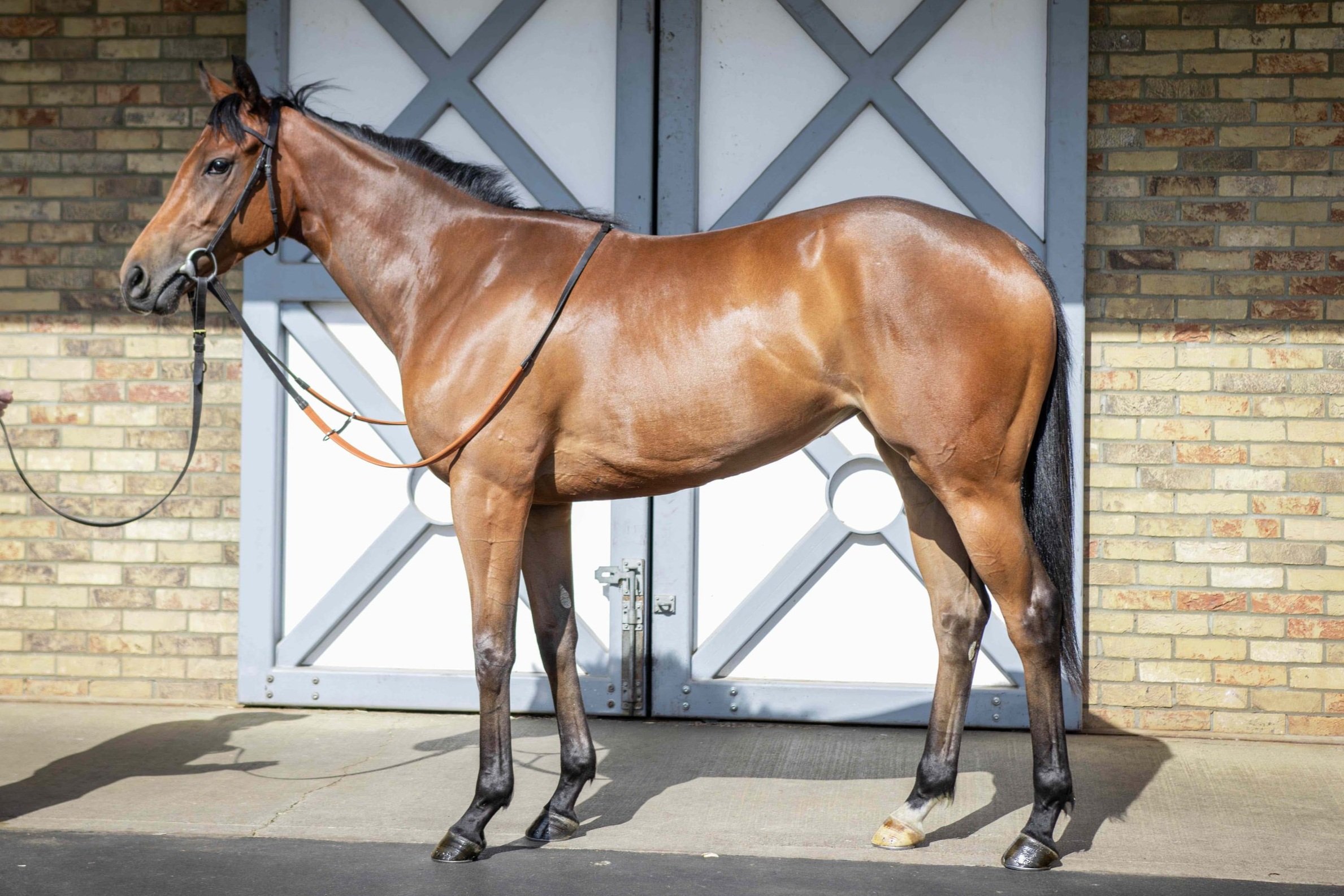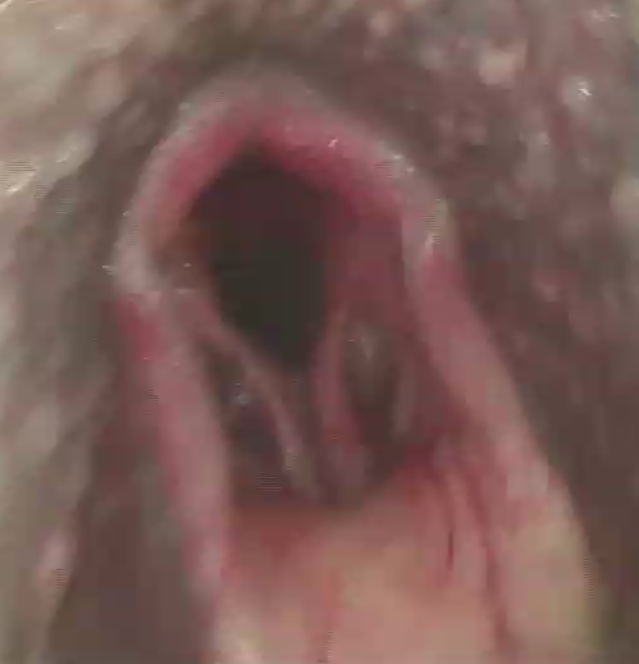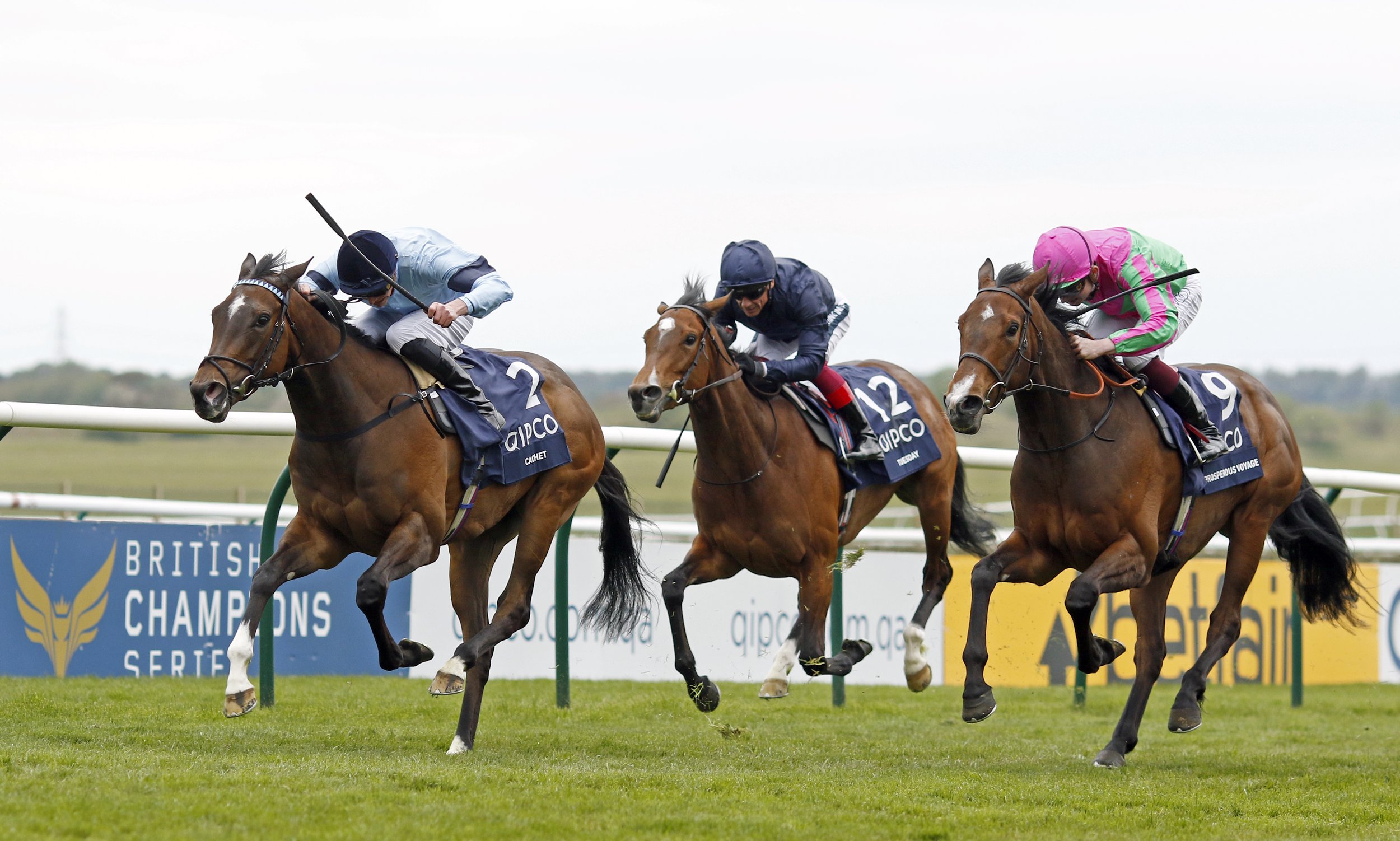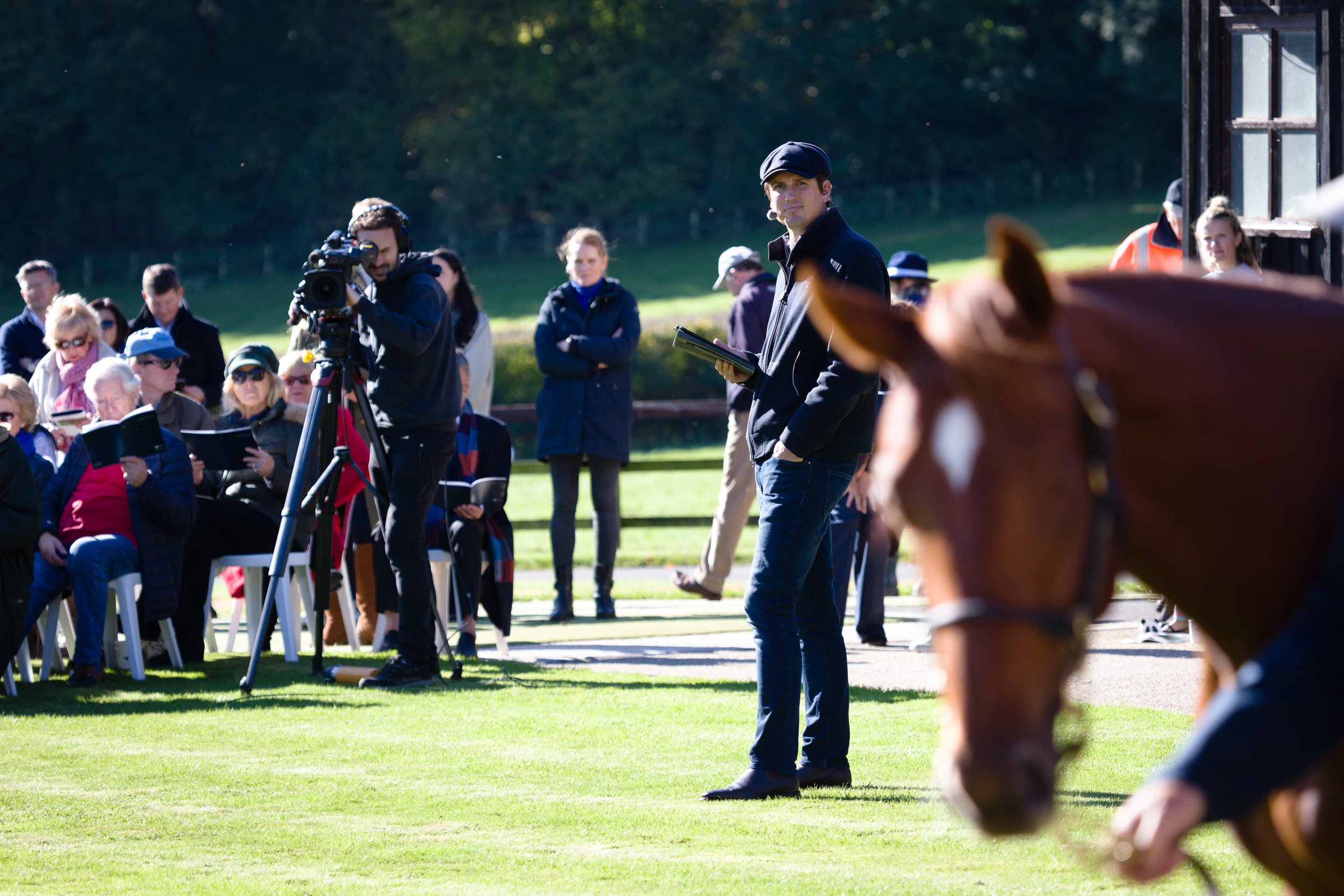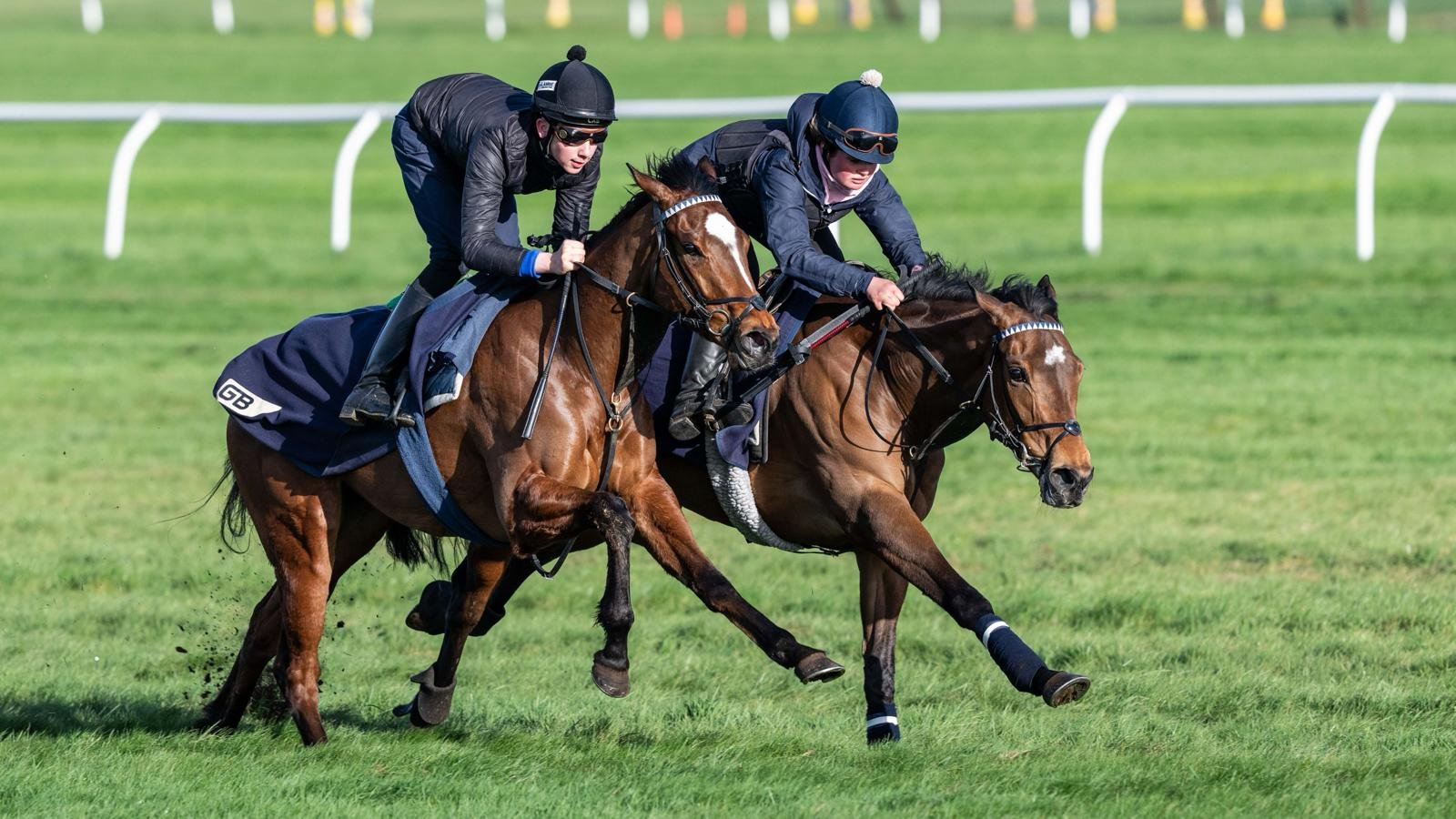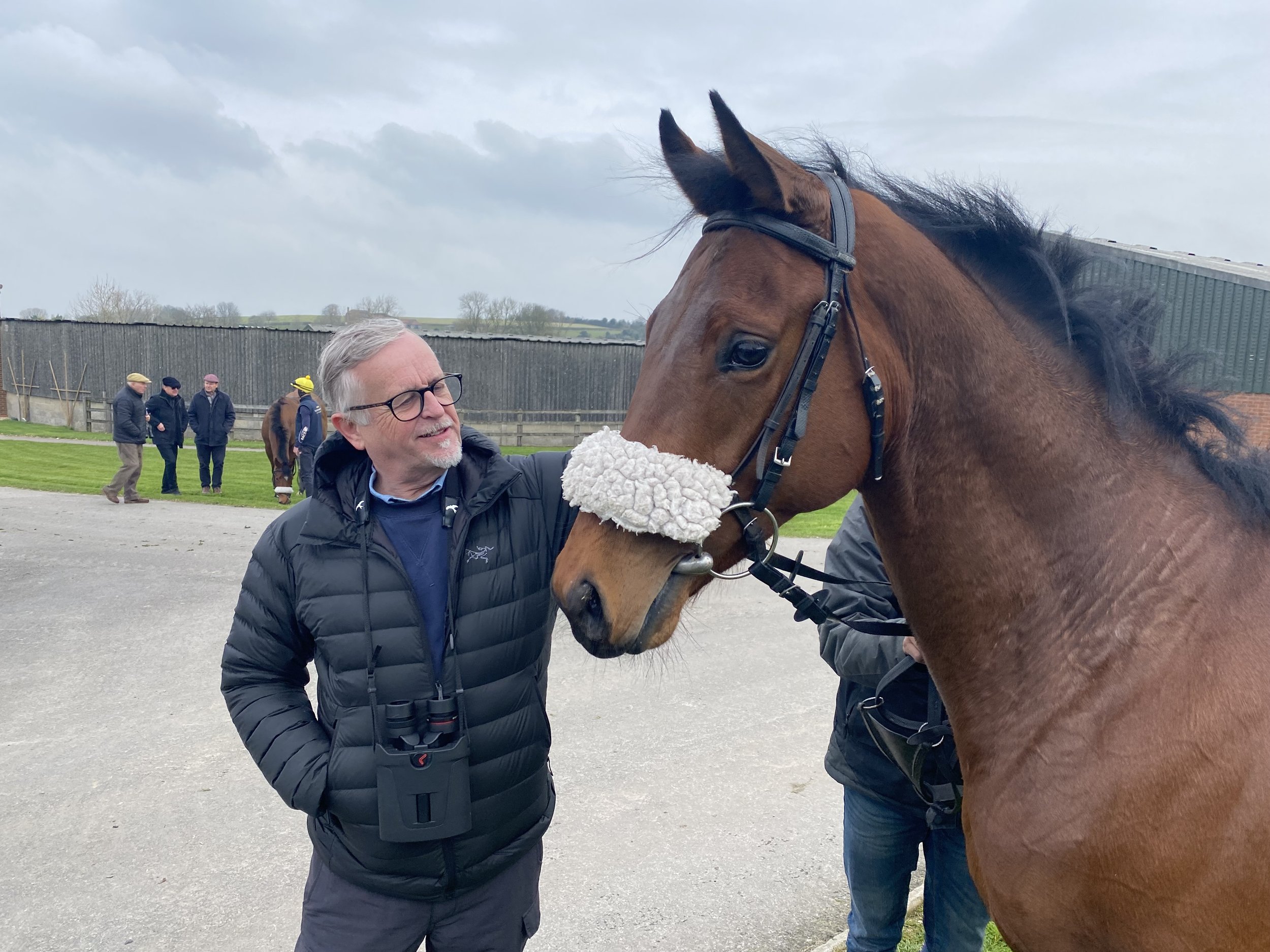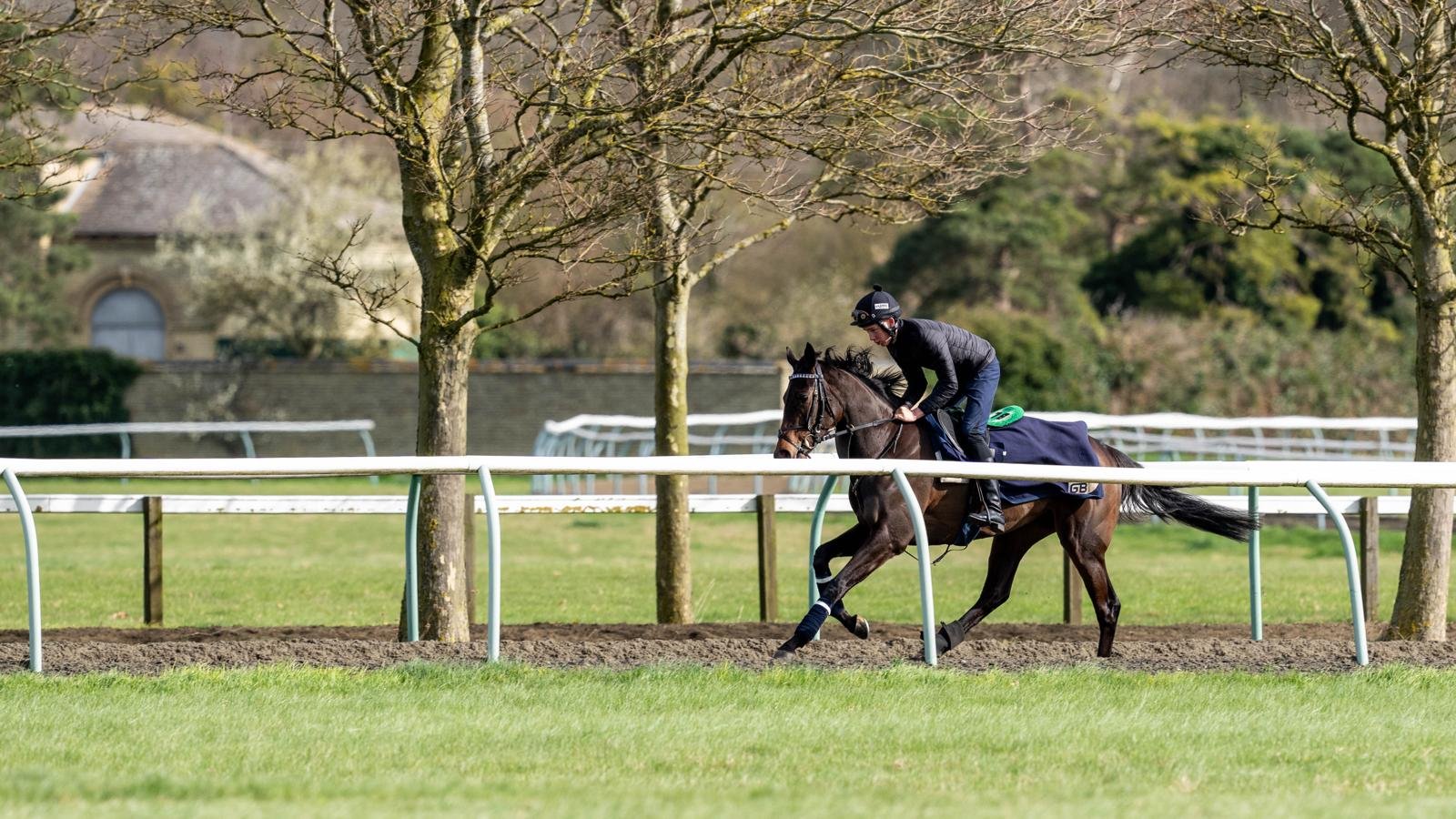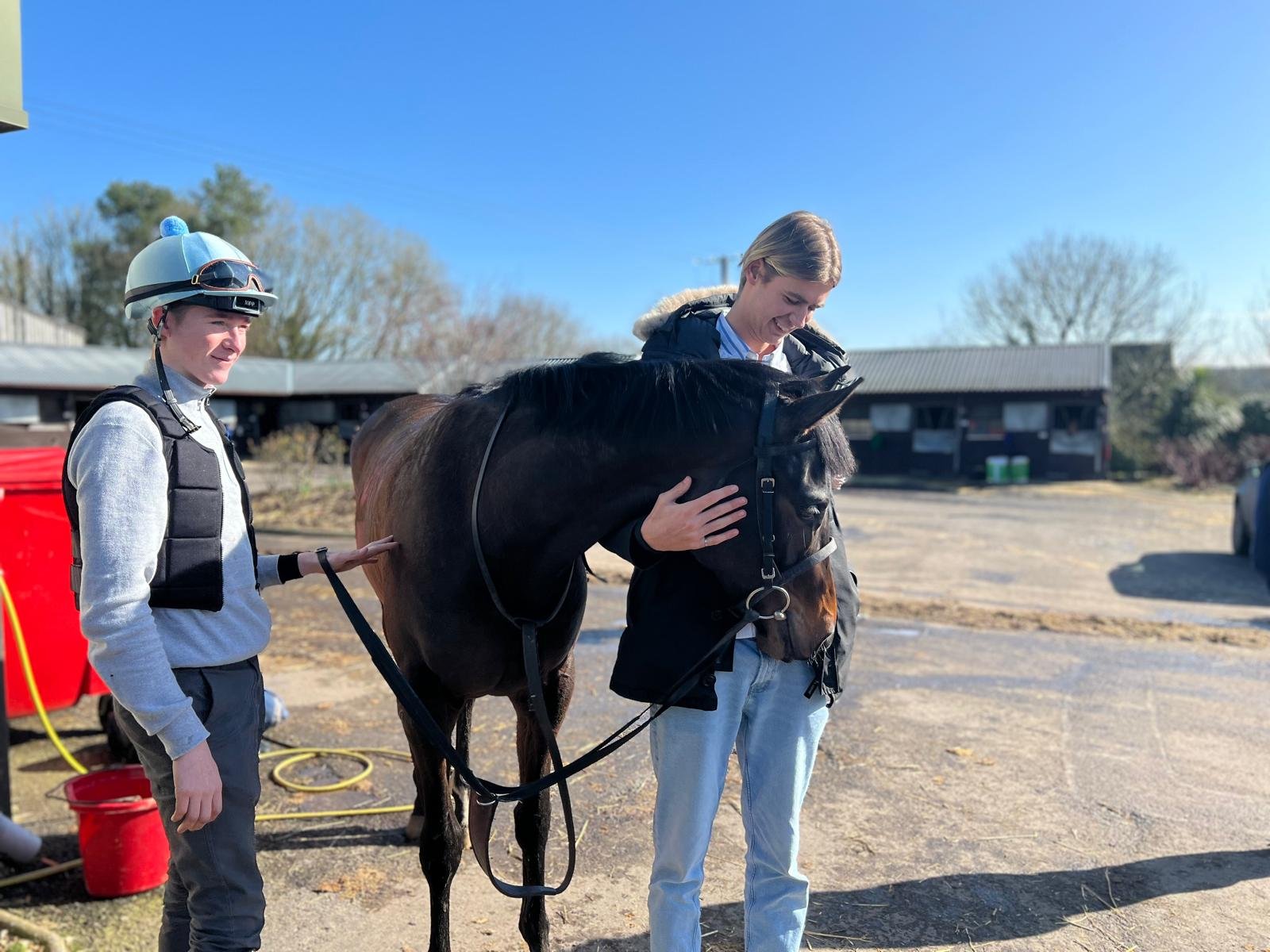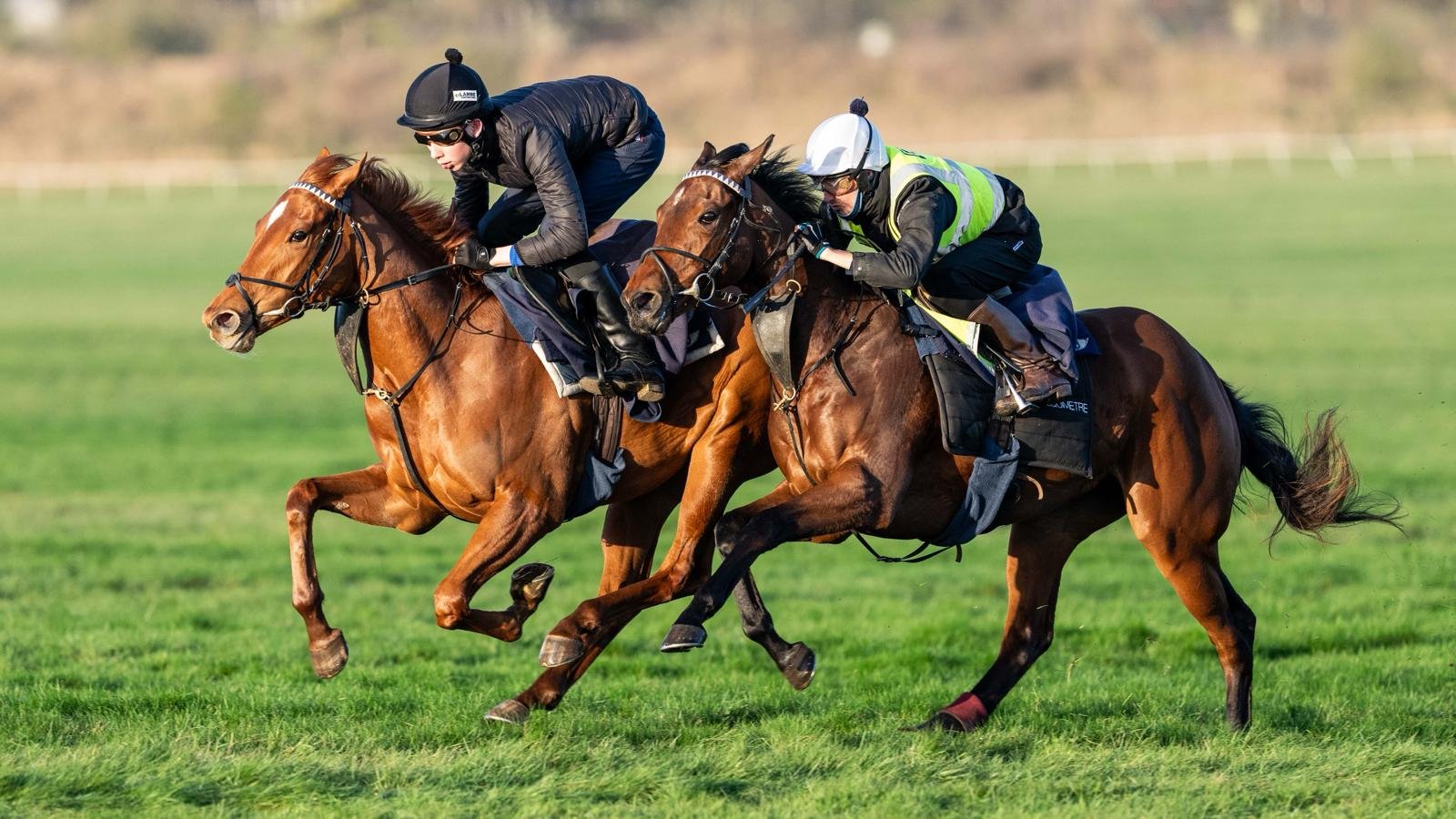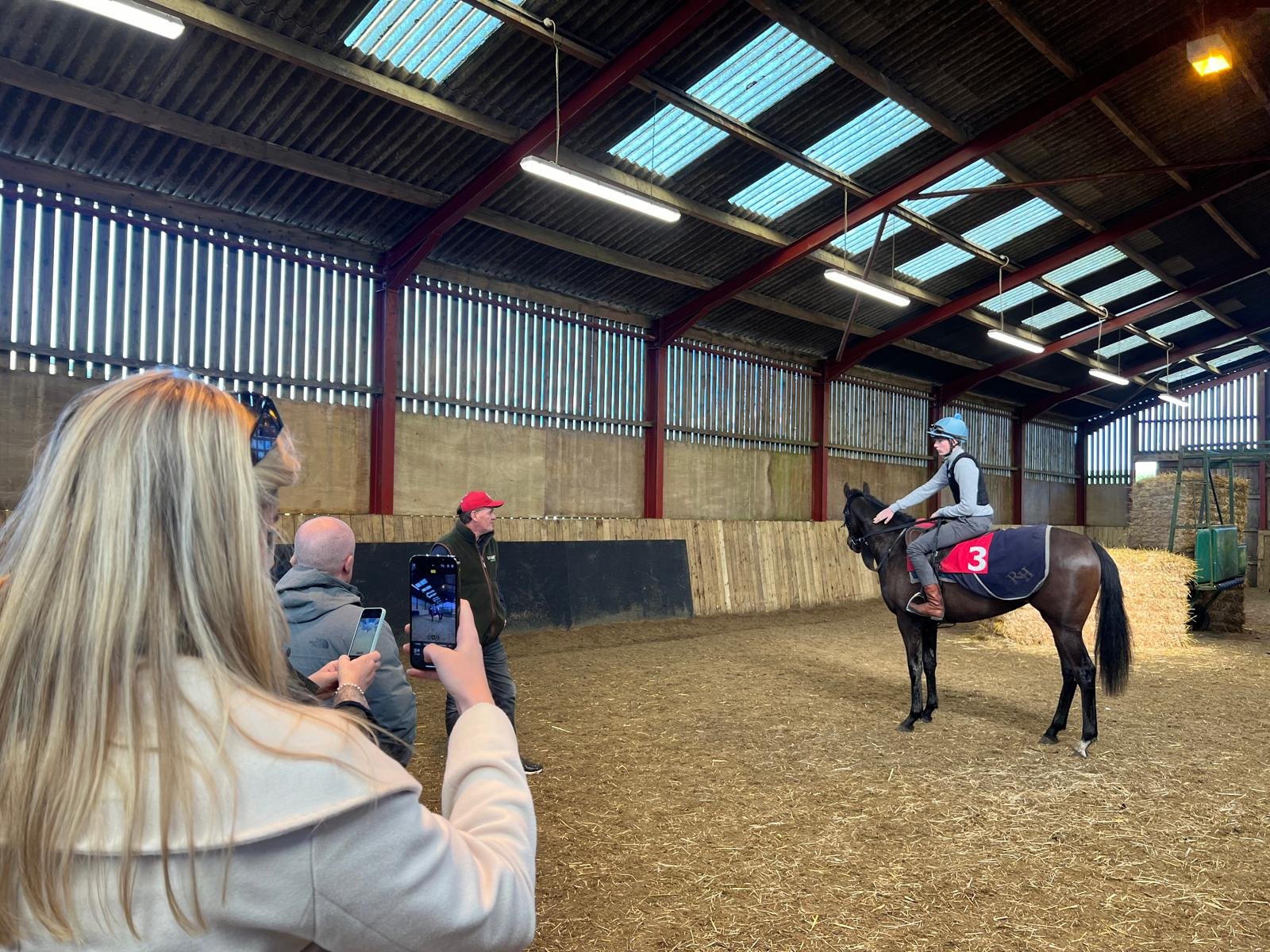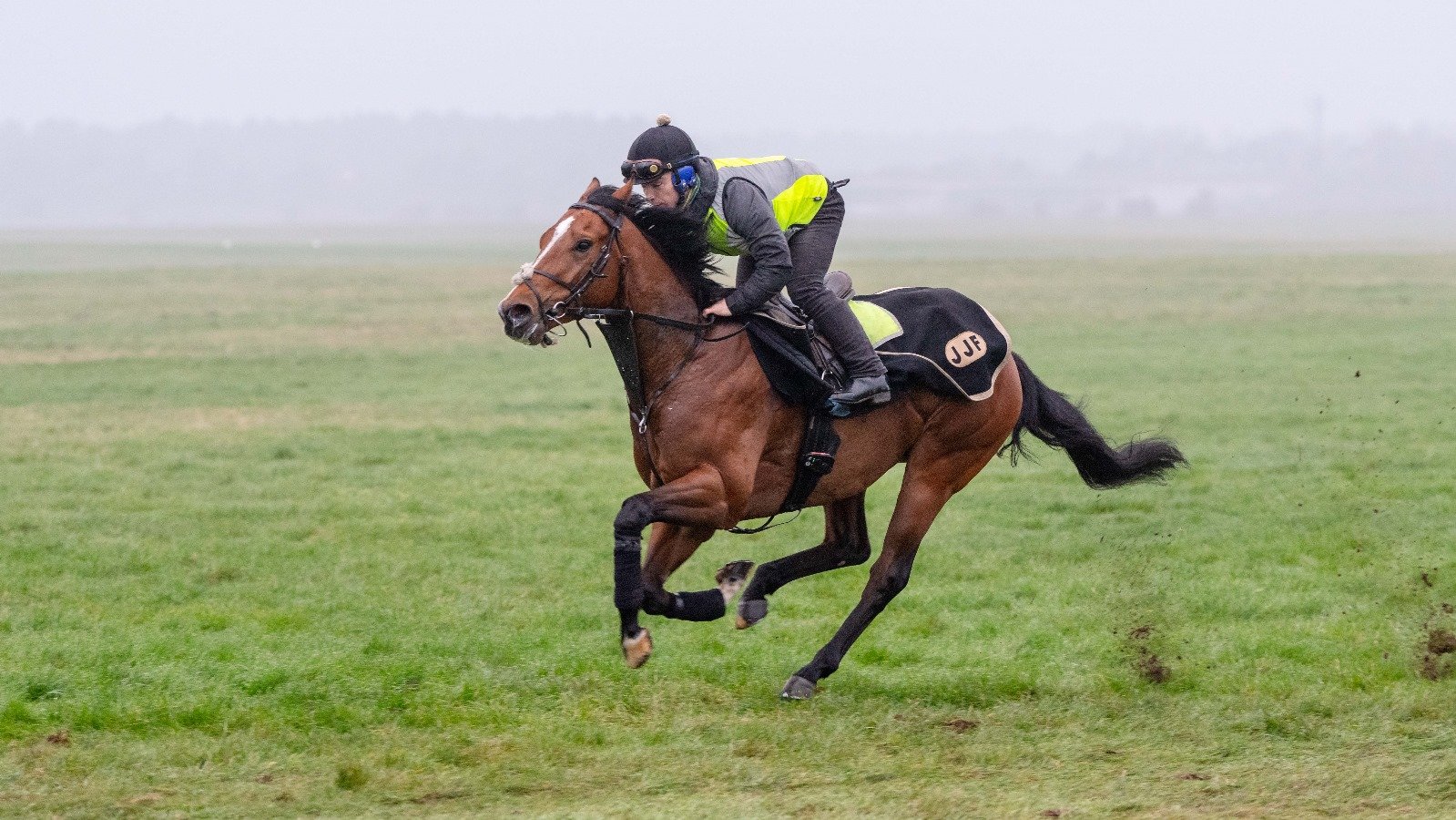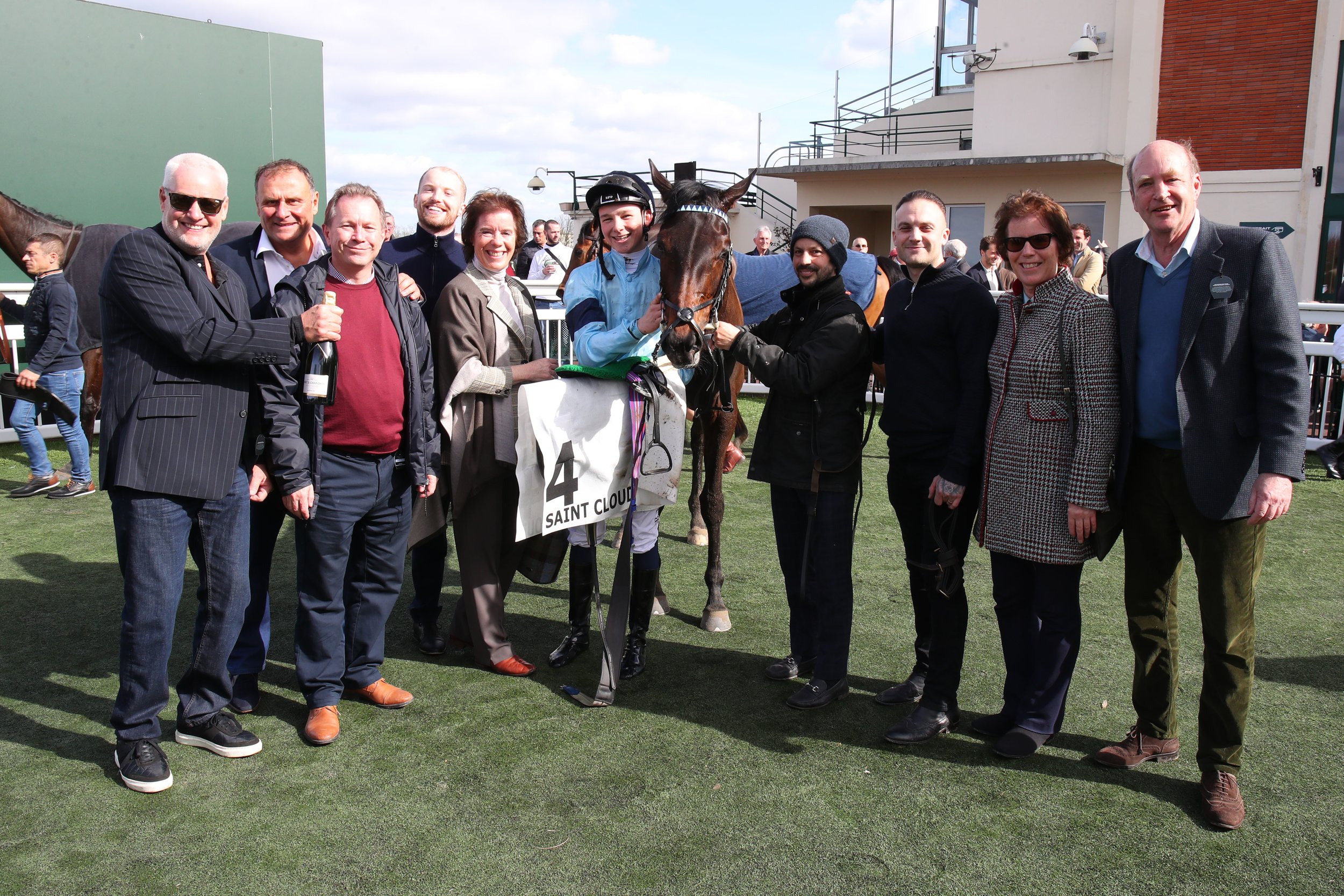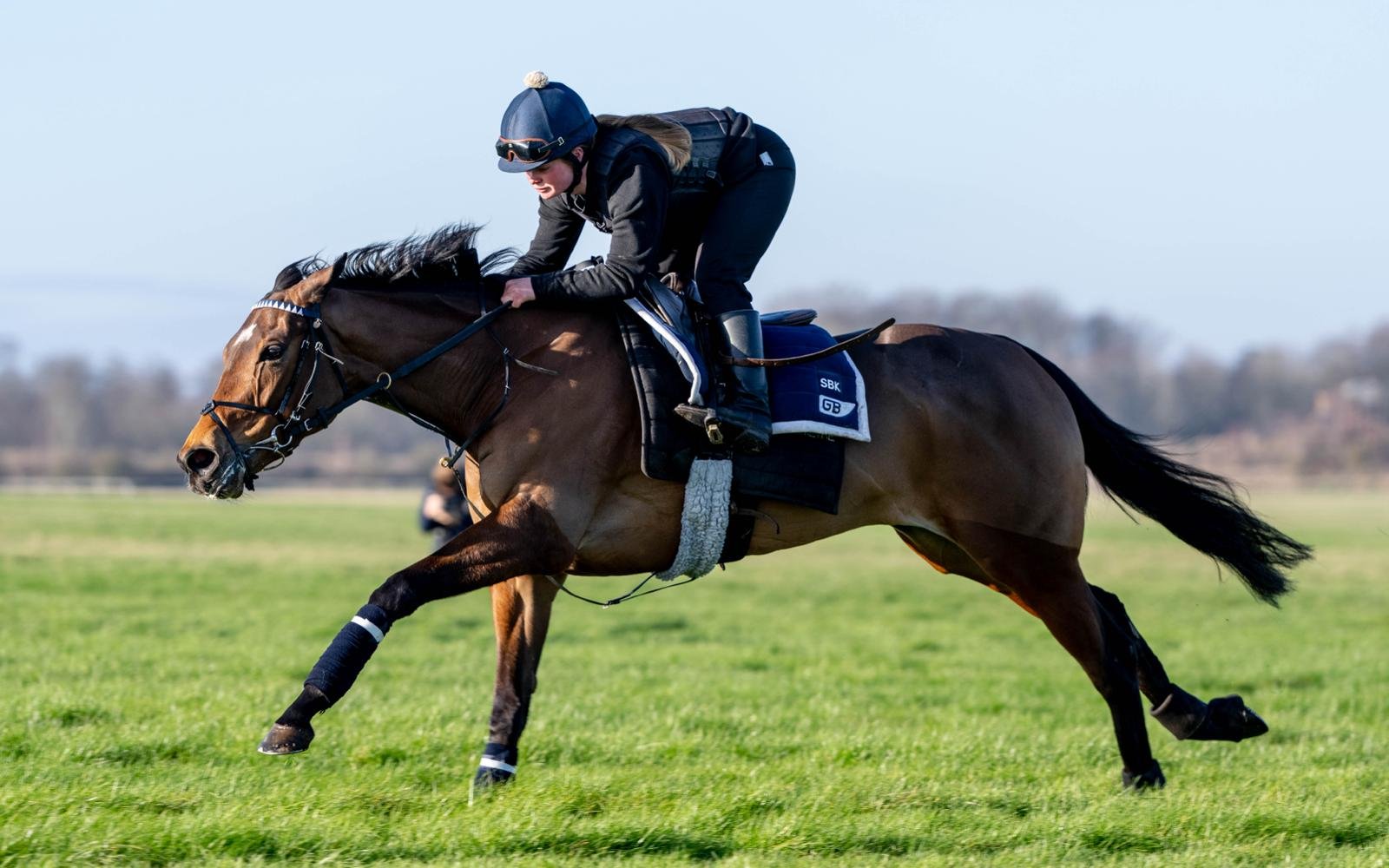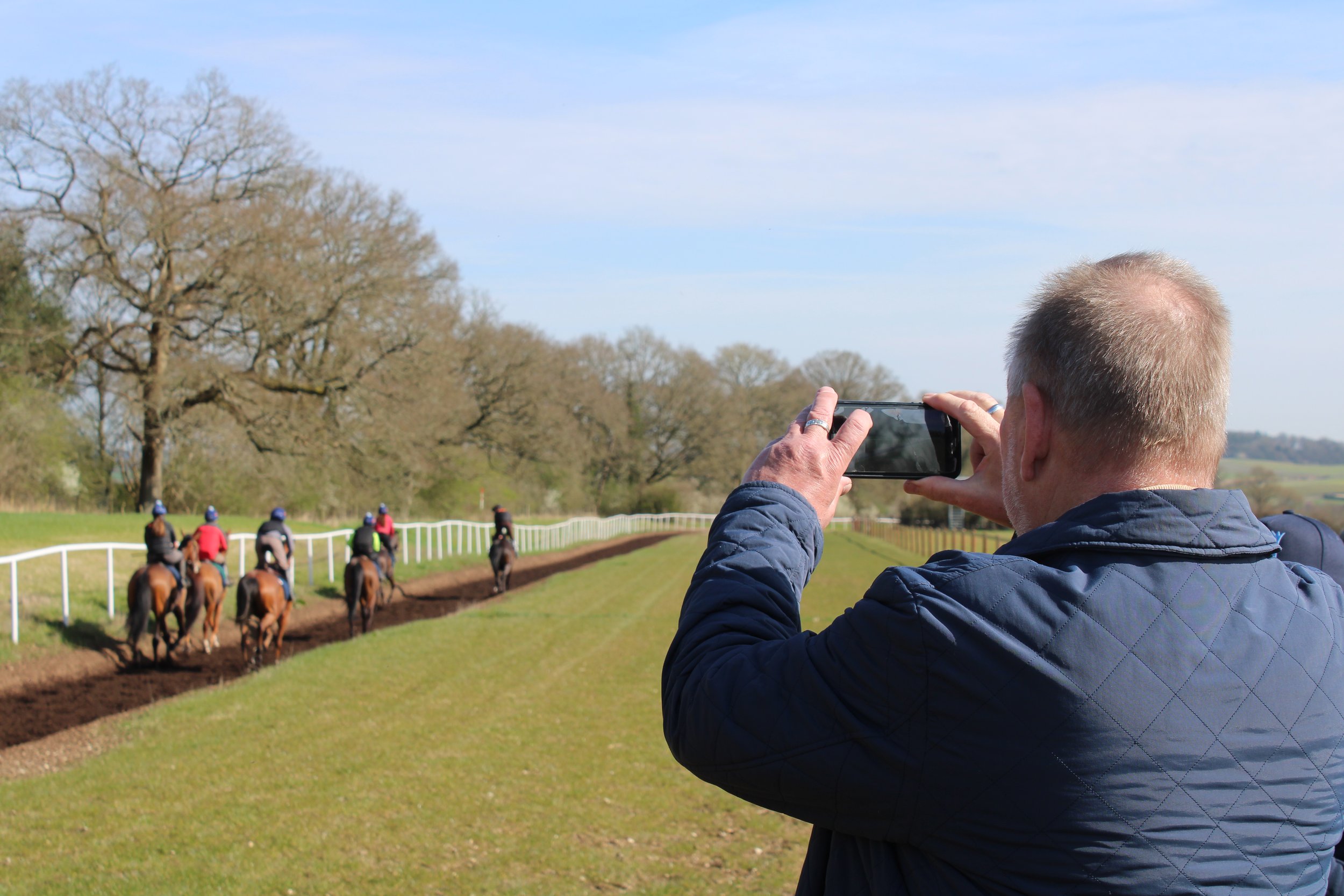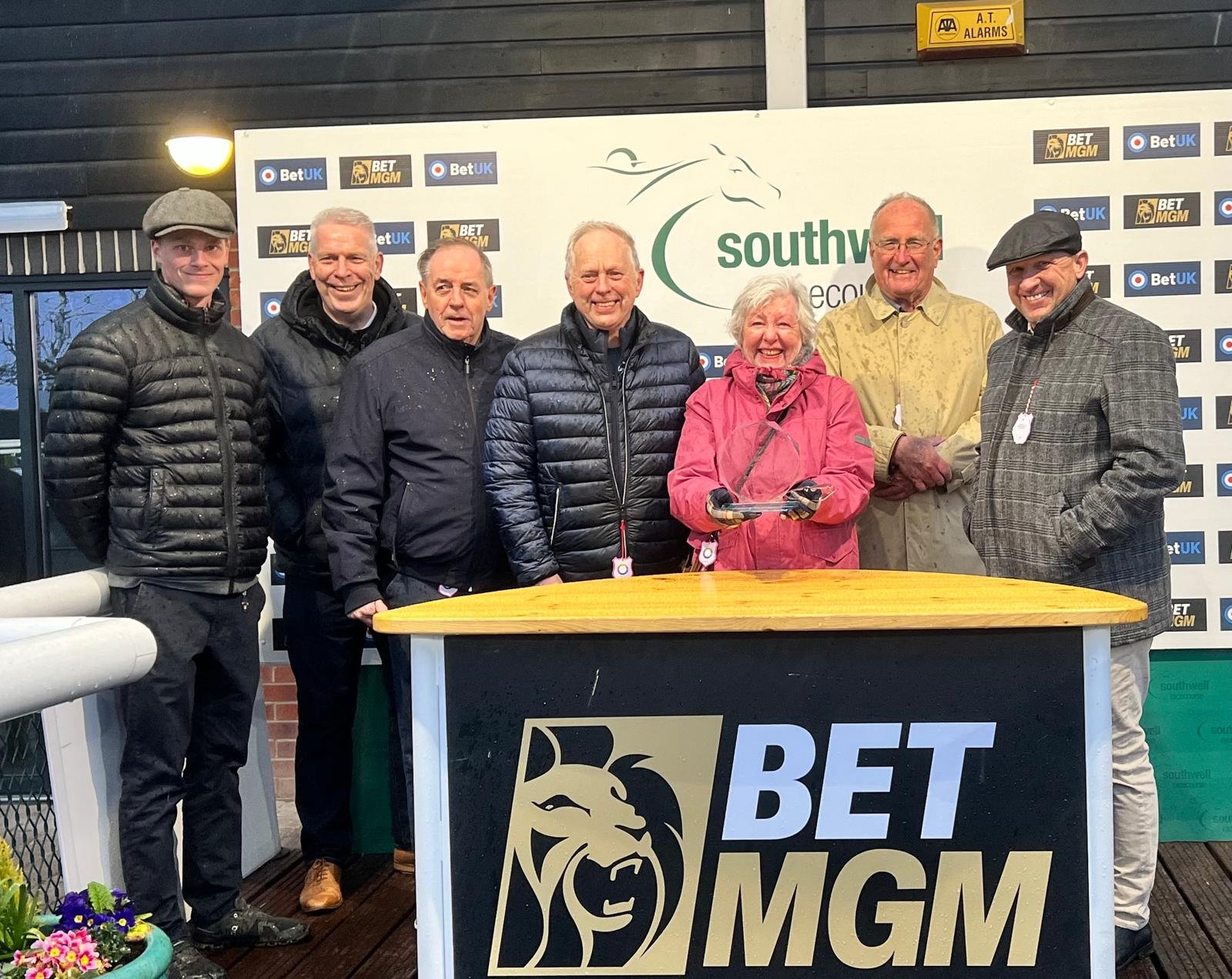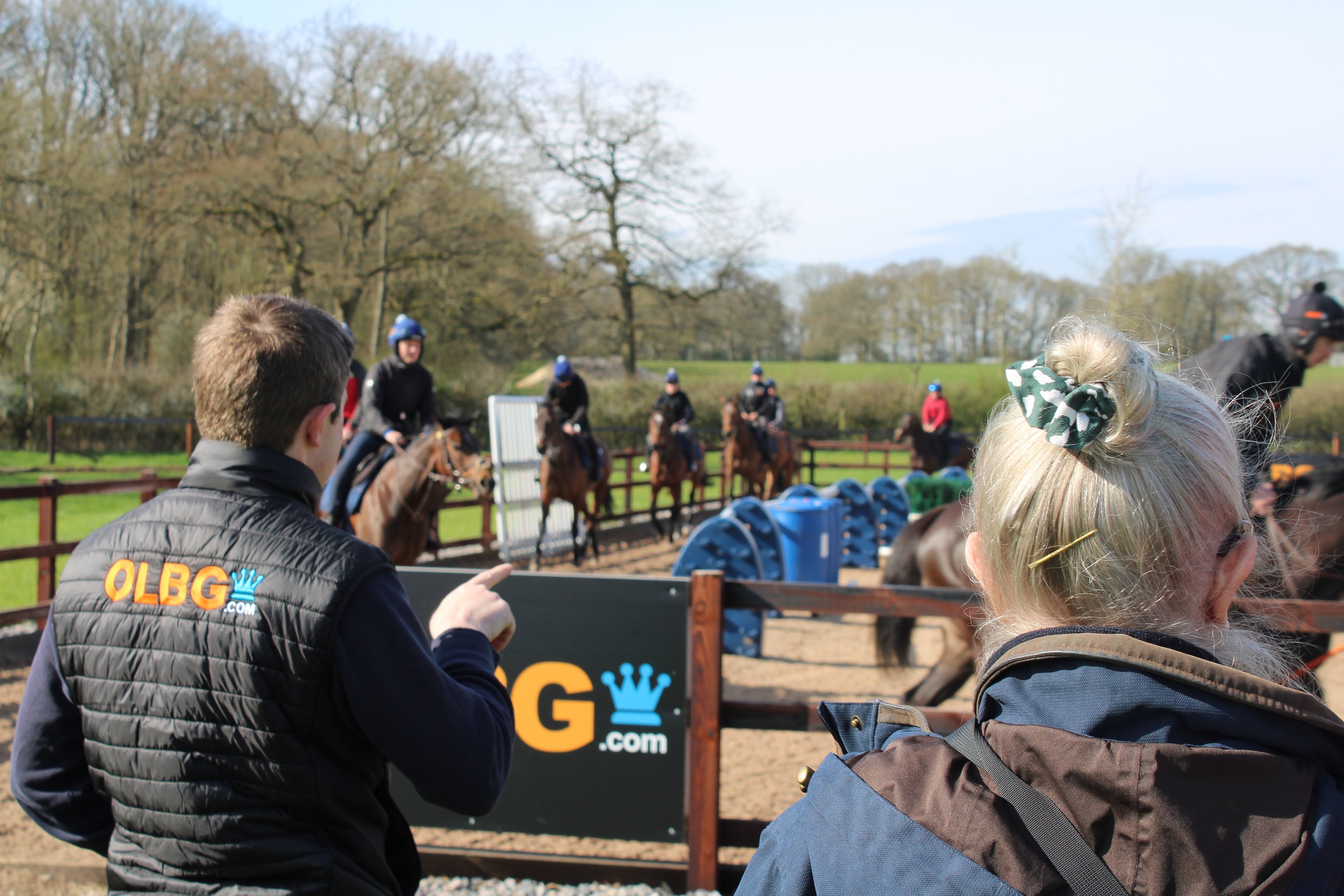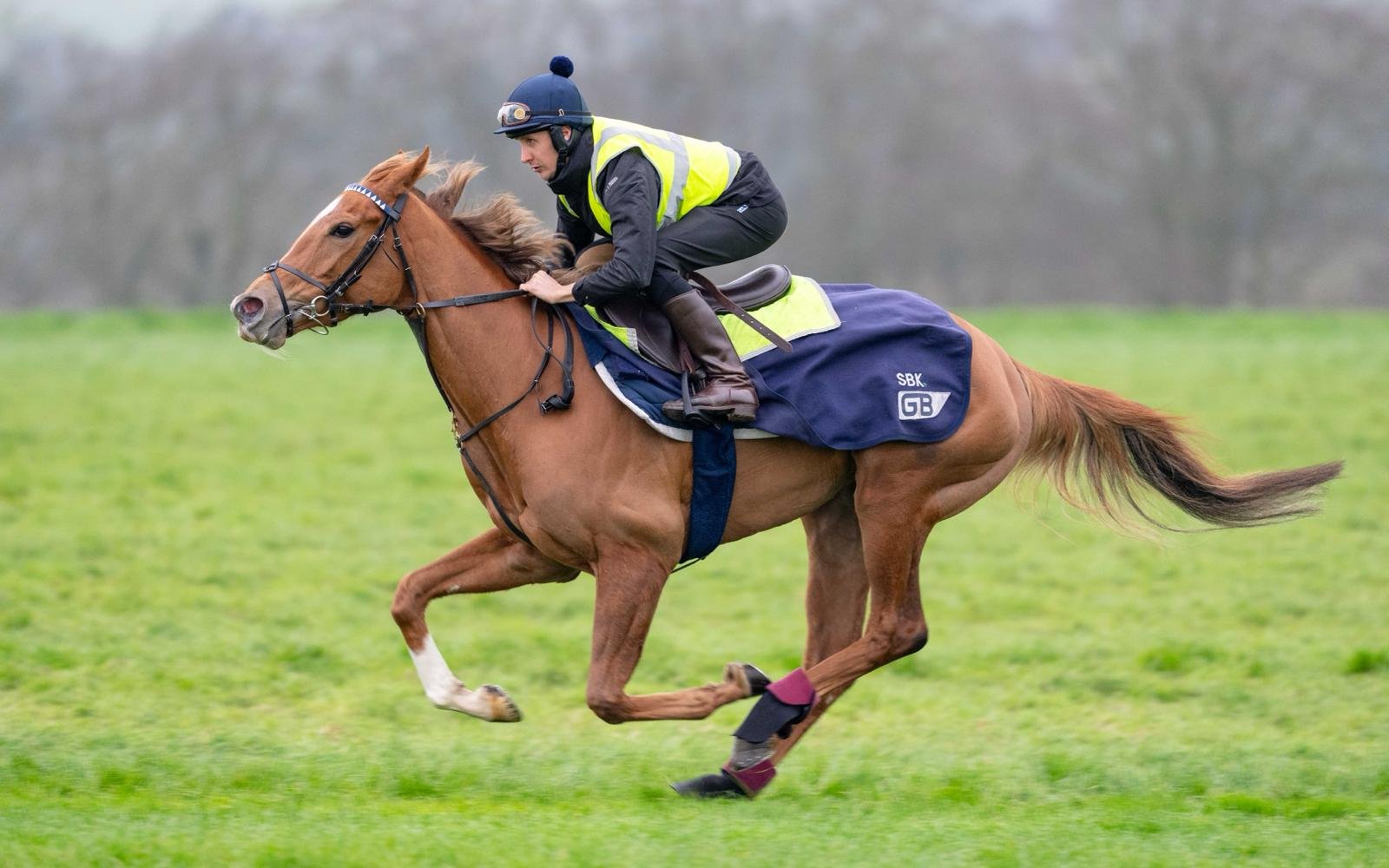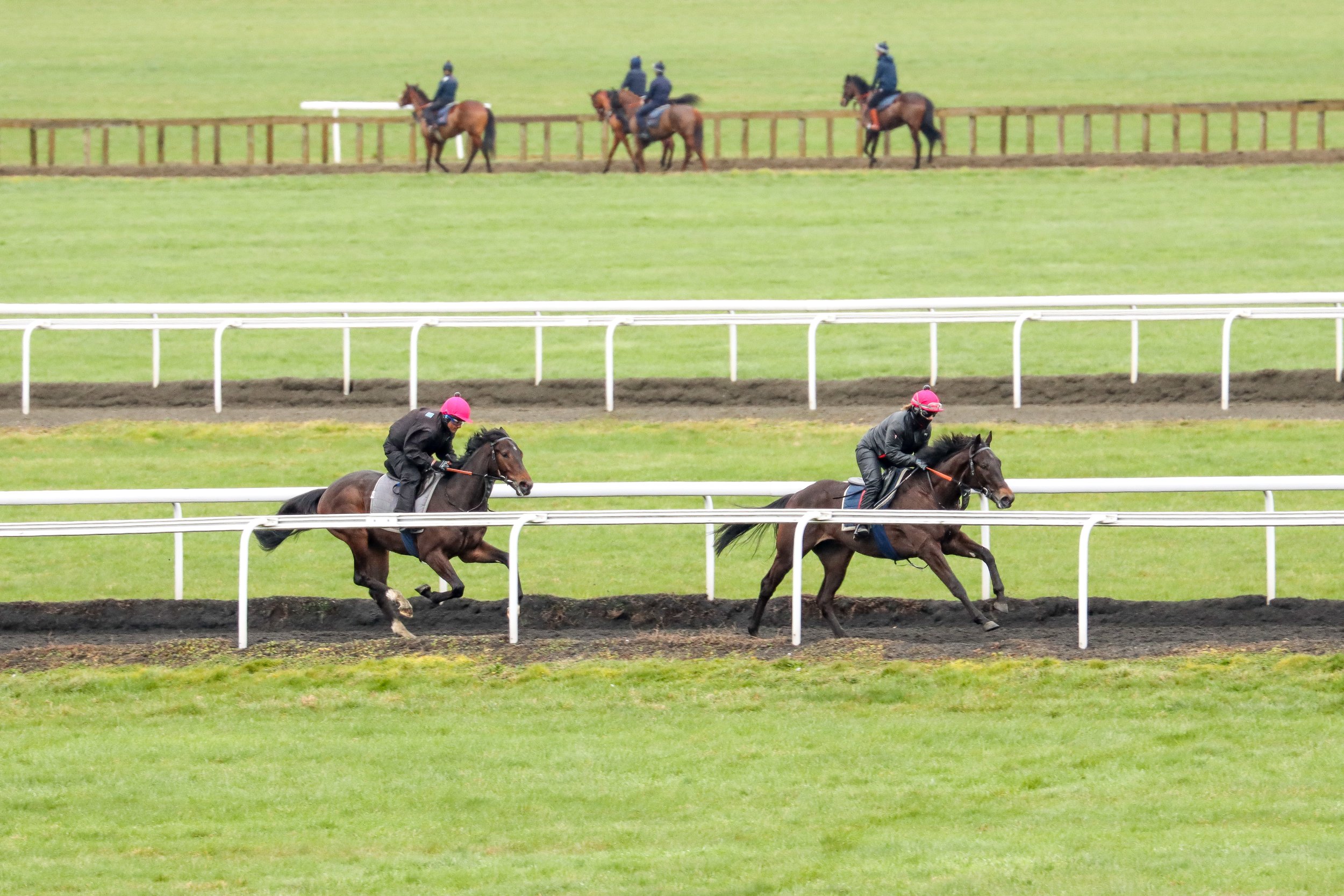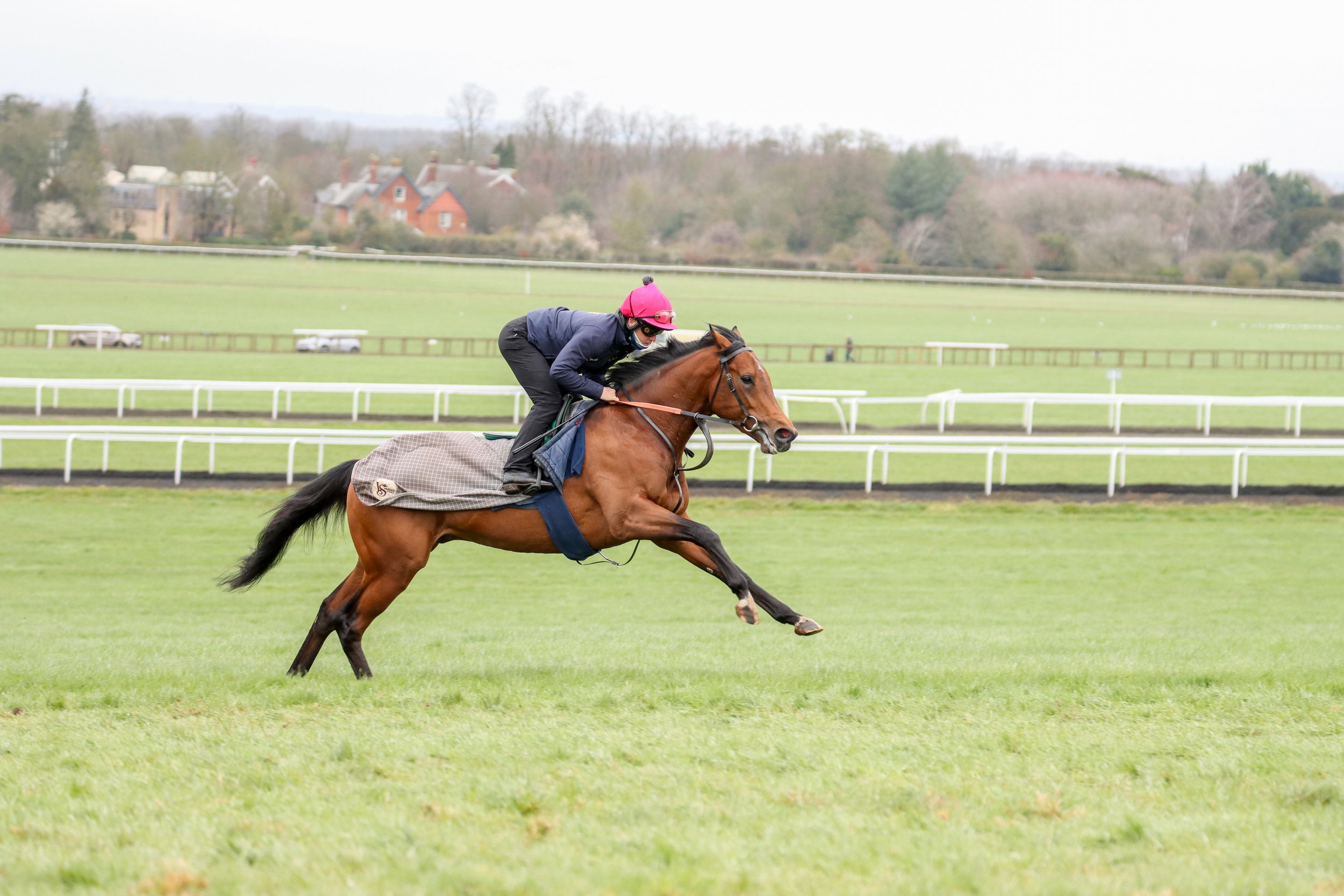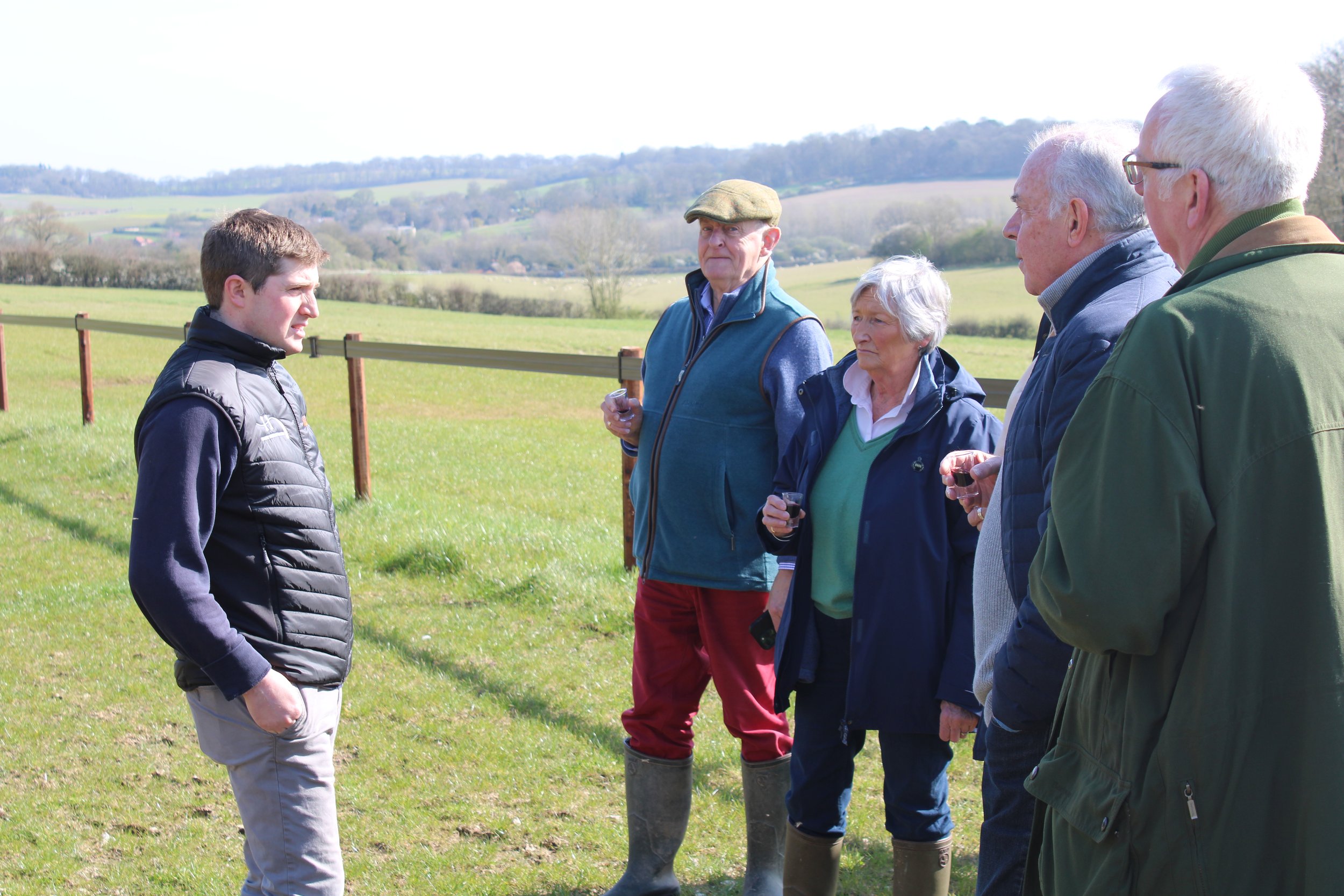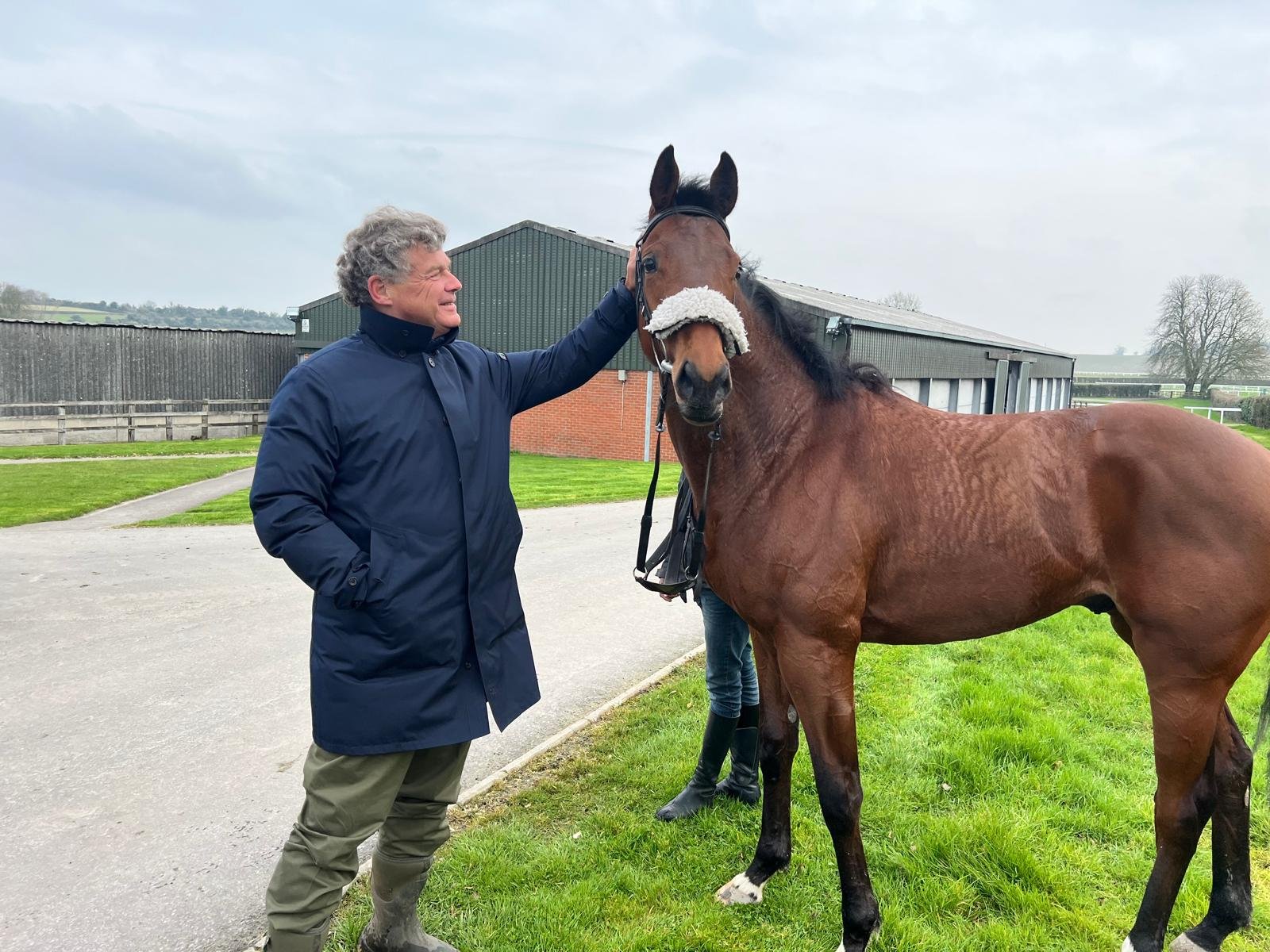MARCH 2024
Believing (far side) who holds an entry in the Chairman’s Sprint Prize (G1) 6f at Sha Tin in Hong Kong on the 28th of April
By Harry Herbert
It’s been an exciting start to the flat campaign with a couple of important winners - most notably Chic Colombine who stormed to victory in a listed race in France by a massive six lengths. She now heads straight to the Poule d’Essai des Pouliches (Gr 1) the French 1,000 Guineas, which is incredibly exciting. Suspicion won again making him two wins from three runs and he looks as though he will be a really fun horse to go to war with this season with Royal Ascot being a prime objective hopefully! With Approval finishing a close second on his reappearance he too looks as though he will be winning next time before moving into some nice handicaps. I was also very pleased to see Cuban Melody making such an encouraging debut to finish second at Kempton. Andrew Balding has always held her in high regard and was hopeful of a good debut and she certainly didn’t disappoint. She is another who could be moving on up into black type races later in the season.
The dreadful wet ground hasn’t helped our trainers at all recently but surely it has to stop raining sometime soon and ideally in time for the classic trials meetings at Newmarket and Newbury. There is much exciting chat in the yards and at George Boughey’s Saffron Lodge Stables Believing’s last piece of work got all the tongues wagging! George has hatched a bold plan for our star sprinting filly which is to go for the Chairmans Sprint Prize (Gr 1) in Hong Kong on Sunday 28th April worth a staggering £1,200,000 to the winner! Our two year old filly Bountiful also continues to catch the gallop watcher’s eye and she will debut at the Craven meeting on Wednesday 17th April!
Our crop of two year olds really are impressing and genuinely do look a very important group of horses. Do look at the available shares part of our website as opportunities abound to get involved in what look to be well above average individuals.
There is much to look forward to!
With my best wishes,
Harry Herbert, Chairman
Horse in Focus
Nightbird (IRE) (2YO b f Invincible Spirit x Policoro)
Nightbird (2yo b f) - at Simon and Ed Crisford’s March 2024
Please CLICK HERE to view a video of Nightbird in training in Newmarket at Simon and Ed Crisford’s taken in early March, and CLICK HERE for a recent canter on the grass on the 16th of March.
We do have a share available at only £10,750 (plus VAT) dont miss out!
On The Track
By Frances de Haan
This month has seen our runners (and trainers) battling it out to get to the track with the good old British weather keeping us on our toes. Despite this the sun has metaphorically ‘shone’ on the track across both Royal Ascot Racing Club (RARC) and our Highclere runners.
Chic Colombine put in a dazzling performance across the channel storming home to victory in the Prix La Camargo (Listed) at Saint-Cloud, to deny the aptly named hot favourite Sparkling Plenty, who had to settle for third. Billy Loughnane, who was riding round Saint-Cloud for the first time, gave Chic a perfect ride. Billy tracked the favourite and as the field fanned out into the straight, he niggled her up into the bridle and the response was immediate. Within a matter of strides she had bounded into the lead, the further she went, the further clear she pulled away from the field. A classy group of horses were left strung out like the washing with six lengths to the second, Nevercry, and a further two lengths back to the favourite, Sparkling Plenty.
Chic Colombine under Billy Loughnane winning Prix La Camargo (Listed) at Saint-Cloud
Winning owners of Chic Colombine
We all hoped that Chic had trained on from two to three and all the signs at home were good, but to stroll to such an easy victory at Listed level is quite remarkable and hopefully a very positive sign of things to come. To top it off this was Billy’s first Listed win! A day to remember for all involved.
Suspicion has gone from strength to strength, making it two on the bounce at Southwell last week. Never mind the rain, it was the wind this time that kept things interesting, but Suspicion looked the true professional in the parade ring. Breaking from stall two James tucked Suspicion in behind the early leaders. He remained hot on their heels until turning for the home straight at which point James asked for more and Suspicion obliged, showing a decent turn of foot to take up the running inside the final 2f. Suspicion ran on strongly to the line to put the race to bed a cosy half a length ahead of second place Vibrato and one and a half lengths ahead of third placed Devoirs Choice. The two rivals he had faced before could not deny Suspicion the prize for a second time!



Cuban Melody impressed us hugely at Kempton where she made a very pleasing debut finishing second, beaten a length and a half by the warm favourite So Quiet.
In the race itself she broke ok before she received a big bump from the horse on her left. This did not seem to perturb her as she settled into stride in a lovely position just in behind the pace on the running rail. Cuban Melody picked up well turning into the homestraight and soon found herself in front under a drive from Oisin. The favourite and eventual winner however came bolting down the rail and Richard Hannon's debutant Nazionale looked threatening down the outside. To be fair to Cuban Melody she picked up again to fend off the challenge of Nazionale and although she could not get back up she did do an eye-catching gallop-out round the bend. Oisin Murphy was very complimentary about how Cuban handled events.
Another pleasing runner up performance, denied by the race favourite, was by Approval at Wolverhampton, where he finished second in a Novice Stakes over 1m 1/2f, beaten a neck by the odds-on favourite Lady Of Spain.
In the race itself Approval broke almost too well and Ben was just able to take back enough to track the keen going Operate through the race. He picked up and found himself in the lead with over a furlong to travel and the eventual winner was in full flight down the outside. In the end he was just denied on the line, but interestingly it was soon on terms again past the line and I think if something had taken him into the race for a bit longer, or if the winner had challenged earlier, he may have got up again. Having said that it is probably for the best that he did not win this evening because he is still inexperienced and another run in a maiden or a novice without a penalty will do him plenty of good with the longer term in mind. He lost very little in defeat and looks a horse full of promise for the future.
Platinum Jubilee wins the Fillies' Handicap at Chelmsford
Meanwhile back on home turf, or the All Weather at least, Platinum Jubilee obliged for Royal Ascot Racing Club (RARC) at Chelmsford in the Fillies Handicap over 1m 2f, settling beautifully under David Probert. This time Platinum found her rhythm and put in a pleasing performance to hit the line half a length in front. She advertised her credentials well and has since sold for a decent price at the Tattersalls HIT sales going on to be trained by Des Donavon.
All in all, an extremely exciting month. With the start of the flat season (and hopefully the warmer weather) just around the corner, we can certainly expect the racing to begin to ramp up in the coming weeks!
GUEST WRITER
by Ben Brain MSc BVM&S MRCVS
Wind surgery, why has it become so common?
The topic of airway surgery or “wind ops” has ever more come to the fore in recent years. Not least due to the BHA’s decision to make it mandatory to declare any surgery, to aid transparency and help the betting public get the full picture. In retrospect the savvy punter can see that this wasn’t much of a help to them. However, it’s raised an issue which if not carefully managed, could prove unhelpful to the optics of equine welfare to those less inclined to agree with the view and goal for all of us involved, that horses in training in the UK are the best maintained and healthiest equines in the country.
The essential message to the uninitiated is that we are not operating on horses to make them run faster, instead we are treating a clinical disease. Whether the treatment is medical or surgical, this is never going to benefit a healthy horse. Trainers are working in a high-pressure environment, with the aim to maximise the performance of every athlete in their yard. Talk of horses improving after a wind op is commonplace, this can provide a false hope to those outside the winners enclosure, hoping that perhaps their horse has a breathing problem. Wind surgery is certainly not a new problem either, although the type of problem we are seeing is changing.
“We are not operating on horses to make them run faster, instead we are treating a clinical disease”
In 10 years between the 60’s and 70’s 30% of the Cheltenham Gold Cup winners had received a “Hobday” surgery to treat partial laryngeal paralysis. It was only in the late 70’s that vets had the ability to view a horse’s larynx with a crude brass endoscope. Prior to that the diagnosis was done by listening to their wind at exercise. Sir Frederick Hobday pioneered a technique to alleviate respiratory stridor by removing the paralysed vocal cords on the affected side of the larynx in the early 1900’s. The British Army, “Hobdayed” over 200 mules at Doncaster racecourse during WW2. Sadly, for those poor beasts the aim was to quieten their vocalisation rather than treatment of an epidemic of paralysed throats. Their lot didn’t improve much afterwards, as they were destined to be sent as pack animals to the British army “Chindit” special forces fighting behind enemy lines in Northern Burma in 1943.
So, unless you happen to be a mule in the wrong place at the wrong time, why do so many equines require wind surgery? Anatomically, us mammals all have a slight weakness on the left side of our larynx. We are all descended from the same conformational blueprint. That ancestor was short necked and with the heart located closely behind the left side of the head, natural selection favoured the nerve activating our throats, to run from the stem of the brain around the heart to the larynx. The right side had a shorter more direct route, as the heart wasn’t in the way. All well and good until over the millennia some species developed long necks, stretching the left nerve to the point where its function was compromised. This is particularly pertinent in the horse, where the left recurrent laryngeal nerve is sometimes nearly 4 metres long, by far and away the longest in the body. An equine heart is the size of a yard bucket and is extraordinary in its power and durability but makes for a bad neighbour if you are a delicate nerve axon passing around it. Hence many horses have a weakness reducing their ability to open the left side of their larynx.
Normal Larynx
Laryngeal paralysis
Vocal cord collapse
The damage to this laryngeal motor nerve is generally progressive, initially the outer fibres are damaged consistent with an abnormal whistling noise when a horse is at canter, this is often not visible when we examine these patients with an endoscope, thus our ears are the traditional mainstay of pre-purchase examinations. As the nerve fibres become progressively damaged, we start to see further collapse of the left side of the larynx. Again, this is not always visible on the scope at rest, but normally there’s a characteristic coarsening of the abnormal noise ending up as a “roar”, these are the cases where examination with the “overground” scope is invaluable, allowing us to monitor the larynx throughout an exercise test. Whatever the grade of paralysis the severity of the noise is a pretty good guide to the severity of the problem. Paradoxically it’s not unheard of to see rising stars in both codes of racing which had been written off at the sales due to a “poor scope” or “making a noise” but then sustain a career without a wind issue ever manifesting
“normally there’s a characteristic coarsening of the abnormal noise ending up as a “roar”, these are the cases where examination with the “overground” scope is invaluable, allowing us to monitor the larynx throughout an exercise test”
pictured horse wearing an overground scope
So, one would hope that when we purchase our shining dream of a yearling or National Hunt store, the wind can be measured and assessed assuring our purchase will be free from any breathing impairment? Sadly not. The nature of this elongated nerve means that damage can occur at any time and often progressively. It’s not all doom and gloom, the vast majority get through their life, athletic or not, without any significant laryngeal impairment. However, there are indicators to look out for which can warn us of a pre-disposition to the problem. The obvious one is size. The longer the nerve, the higher the likelihood of malfunction. The breeding game is tough enough, but triumph can turn quickly turn to disaster, the elation of producing a strapping colt foal, which is feted upon his arrival at the sales, can suddenly vanish as he is passed over, after a few vets have been around with their scopes and word gets about. Perversely its not just size, geneticists have tentatively found the genes for speed are neighbours to those predisposing to laryngeal paralysis, making it more likely that the two traits are likely to be inherited together. Heritability has been a known factor for a long time. Many a sire’s breeding career has been cut short by a larger than normal percentage of their progeny identified with a laryngeal problem, paradoxically the stallion may not necessarily have expressed the problem which was lurking in his genes.
Armed with this knowledge as well as staring up at the mountain of obstacles between purchase and the winner’s enclosure, the aspiring owner might be forgiven for feeling disheartened. But take heart from the fact that this disease has never been so well understood, diagnostic techniques and their ease of application have made enormous strides over the last 20 years and the communication and understanding between vets, trainers and bloodstock agents at the sales, has made purchasers far more informed in their decision making. Treatment has similarly improved, the use of a laser to perform the traditional Hobday as well as improvements in other surgeries such as laryngoplasty, or Tie-backs as they are known, as well as nerve grafts mean that a diagnosis is seldom the end of a racing career.
Q & A corner
by Jake Warren (owner Highclere Stud)
Breeze Up Sales
What is a Breeze Up Sale?
A Breeze Up Sale, to a large degree, is very similar to a yearling sale in the sense that they are all unraced horses. The majority of these horses have been sourced from the yearling sales in the previous year. The key difference being that they are able to gallop two furlongs as a part of the sale process.
So, the difference between a Yearling Sale a Breeze Up Sale is we get to assess them on the move and work out their stride length, the times that they breeze and get a little bit of an understanding of their soundness.
What is the process of selecting a horse in a Breeze Up Sale?
The process starts by analysing the breeze which tends to take place the day before the horses sell in the ring. We get a chance to watch them all gallop one after the other, over the two furlong distance. Then we go to look at the ones we are interested in at the sales complex before they go through the ring.
Depending on what type of horse we want to buy, we look for a well-balanced horse, one that's got an easy rhythm with their action. One that has got the mental ability to stay in a straight line and gallop professionally. Then the key thing is, after they have galloped, is to assess how they are with regards to soundness and how they've taken that gallop.
Highclere have had huge success over the years with the likes of Cachet, Believing and Spycatcher – is there a secret recipe in what you are looking for in a Breeze Up horse?
It has been a great success story purchasing the Breeze Up horses for Highclere. I think that the secret is probably the fact that we've been able to buy horses with a very similar conformation and pedigree that we have also had great success with when buying yearlings. This, mixed in with the ability to watch them move and gallop. We love to see a progressive time, a horse getting faster as a breeze and hitting the line strongly. I think the combination of all of the expertise we have in purchasing yearlings, added in with the additional data that we get from assessing them on the breeze, makes for a good combination and has largely been the reason for the success.
Cachet winning the 1000 Guineas Newmarket 2022
Breeze Up Sales are becoming more and more popular – why is this?
Breeze Ups are becoming more popular because they provide an immediate return on the investment, in the sense that you can buy a horse, and it can be on the track within six weeks from purchase. This is not the case when buying a yearling, where you have to wait more like six months. So, the speed of seeing the results of purchase definitely helps.
We also are seeing the breeze up consigners, who are the people that purchase yearlings and then resell them, becoming a lot more professional. They are investing more in the purchase price of the yearlings, which definitely helps in the sense that there is a higher quality of stock on the market and the combination of those two things means that there are definitely some better horses available at these sales.
Is it important to you to support the various types of Sale?
We've had a lot of success of the Breeze Ups buying horses. But the key difference to a Breeze Up Sale and a Yearling Sale is that it is a much smaller pool of horses. So, although they are a wonderful sale to attend, and we try and pluck out the horses that we think are going to be most suitable for us, in truth it is still a very small pool of horses compared to the Yearling Sales. This is why the Yearling Sales are always going to provide the largest selection of horses on offer and therefore tend to be where we will do the majority of our buying, because there are significantly more horses to choose from.
The Breeze Ups are a small select group of horses, which means that we really only get the chance to buy one or two out of those sales, versus the larger numbers that we can buy at the Yearling Sales.
Jake studying the horses at our own Highclere Yearling Parade
What do you personally like about the Breeze Up sales?
I really like the additional data that we get when attending a Breeze Up Sale. The ability to watch the horses gallop and the ability to get feedback from a jockey. The ability to check for soundness, post the gallop, all gives us a tremendous amount of confidence when we start to dial into the few horses that we really want to buy on the shortlist.
The rest of the principles are very similar to Yearling Sales and so watching them stripped off back at the auction facility and seeing them walk up and down watching how they've taken it mentally, is all additional data that allows us just to be perhaps a little bit braver and a bit more confident about the horses that we really want to buy.
That time of year again!
by Alex Smith
What do Anjelina Jolie, Cameron Diaz, Sarah Jessica Parker, Drew Barrymore and Kylie Minogue have in common?
Yes they are all celebrities of stage & screen…. And they all produce rose!
Well, when I say produce, an increasing number of stars have bought acres of vineyards/lent their name to the pink stuff which is arguably the most exciting (at least in growth terms anyway) in the wine business right now.
And the above are just the girls! George Clooney got in the act having purchased four hectares of vines which form part of the Domaine de Canadel in Provence, from which two wines are due to be released this year. Before George, John Malkovich, Graham Norton, John Bon Jovi, Sting, Gary Barlow and Snoop Dogg have all got in on the act.
Back to basics-how is rose produced?
The best (in my opinion) are produced by crushing red grapes and then letting the skins to remain with the juice for 24-48 hours-depending on how light or dark you would like the finished product to appear. Lesser roses are made by pressing together white and red grapes, often resulting in an inferior end result.
Grenache (the work horse of red wines in the Rhone) is the most used grape used in the production of rose in Provence, which produced 150 million bottles in 2020, or 42% of all French wine! Rose accounts for more than a third of the market in France!!
The global consumption of rose has risen by 17% since 2000 with red wine declining by 15%. The fastest growth in rose consumption in the past two decades has been-you guessed it- the UK. This against a backdrop of falling wine consumption, with the real surprise in the massive reduction of red wine consumption in France, down to half of what it was in the 1990’s!
Now the average French citizen drinks just 40 litres a year compared to 100 litres in 1975!! I’ve noticed this worrying trend with my own children.
But of course with the rapid expansion of the rose market, wines from all over the world are jockeying for our attention from modest price points to the faintly ridiculous. There is no doubt that the quality has improved but to my mind some of the pricing is way ahead of what’s in the bottle.
How big is it?? The global market reached 3.1 billion dollars in 2022 and is set to grow to 4.6 billion by 2030!
So where to start? Many of us will have our favourites but there is a miriad of new wines available from Italy, Greece, Spain, Portugal, Austria, California, South Africa etc from which to choose. The rapid expansion in production has coincided with an increase in poor quality wines, so doing your research has become even more important.
We did a small tasting in the office from a selection of wines from M&S. It is fair to say that the top two-Whispering Angel and Miraval came out on top-a slight preference for the Miraval, the Whispering Angel having a slightly boiled sweets taste which I found off putting. There are plenty of good examples from regions in France other than Provence, and any good local wine merchant will have sourced something of very decent quality and probably costing a good deal less than the better known wines, which benefit from having big marketing budgets behind them. I have always been a fan of Peyrassol from Majestic (£12.99 if you buy six bottles).
Anyway following a terrible winter, it will be good to be once again sitting outside (when the rain finally stops!) enjoying a drop of the pink stuff!
Where Are They Now?
by Frances de Haan
A simply uplifting update from Cameron (straight from the horses mouth so to speak) on Civilian for this months ‘Where Are They Now’, including some glorious (and hugely welcomed) sunny pictures. Thank you Cameron!
‘‘I'm so excited for our future and cannot wait to see what we can achieve!’
‘I bought Dylan last April and have been slowly retraining for a dressage/eventing career.
We've spent a long time hacking and long lining exploring the Devon countryside. The hills have done Dylan wonders teaching him how to use his core and improve his topline.
Dylan is learning to carry himself properly in the arena and we are building this up slowly to hopefully get out to some dressage in spring.
Dylan is the sweetest and most inquisitive little man and is a firm favourite with the dentist he loves a visitor and thrives being the centre of attention.
I'm so excited for our future and cannot wait to see what we can achieve!’
Clodagh’s recipe
by Clodagh McKenna Herbert
SPRING CHICKEN POT PIE
METHOD: INGREDIENTS:
Serves 4
560g chicken, cooked and shredded
80g butter
2 leeks, sliced thinly
240g chestnut mushrooms, sliced
3 cloves garlic, crushed
1tsp fresh thyme leaves, finely chopped
90g fresh spinach
40g white plain flour
100ml white wine
500ml of chicken stock
150ml double cream
Zest of one lemon
1 tbsp Dijon mustard
160g frozen peas
6 asparagus spears, chopped into 2-inch pieces
2 tbsp fresh flat leaf parsley, chopped
sea salt and freshly ground black pepper
For the pastry
8 sheets filo pastry
2 tbsp melted butter
1. Pre-heat the oven to 180oC / Gas mark 4.
2. Place a frying pan or casserole dish over a medium heat and melt the butter. Then stir in the leeks, mushrooms, garlic and thyme and cook for 5 mins until soft. Next stir through the spinach and cook until it starts to wilt, about 2 minutes.
3. Sprinkle the flour over the leeks and mushrooms, stir and cook for 1 minute. Next add the white wine, chicken stock, cream, mustard and lemon zest while stirring. Bring to a simmer and cook for 5 minutes or until mixture is a thick gravy like consistency. Season with sea salt and freshly ground black pepper.
4. Add in the shredded cooked chicken, frozen peas, asparagus and chopped parsley. Stir well to combine then remove from heat and allow to cool slightly
5. Transfer the pie filling to a pie dish or a shallow casserole dish. Scrunch the filo pastry sheets over the mixture, brush with melted butter and bake in the pre-heated oven for 20-25 minutes or until the pastry is golden brown and filling is bubbling at the sides.
Taittinger Moment
Ollie Sangster (trainer)
This month’s Taittinger moment goes to one of our newer young trainers Ollie Sangster, for Suspicion’s spectacular double. First at Kempton in the Unibet Zero% Mission Novice Stakes over 1m and subsequently at Southwell, in the Boost Your Acca At BetMGM Novice Stakes over 1m.
Long may the winning streak continue!




